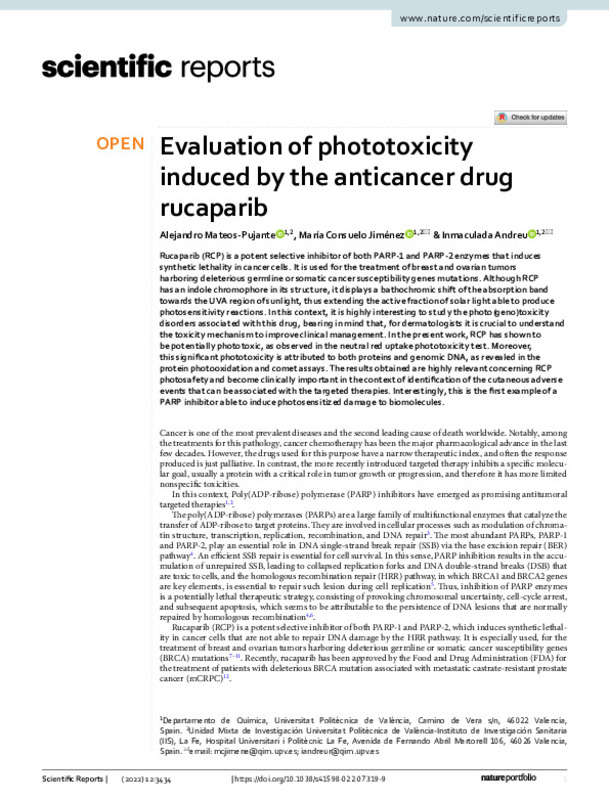Sonnenblick, A., de Azambuja, E., Azim, H. A. Jr. & Piccart, M. An update on PARP inhibitors-moving to the adjuvant setting. Nat. Rev. Clin. Oncol. 12, 27–41 (2015).
Michelena, J. et al. Analysis of PARP inhibitor toxicity by multidimensional fluorescence microscopy reveals mechanisms of sensitivity and resistance. Nat. Commun. 9, 2678 (2018).
Schreiber, V., Dantzer, F., Ame, J.-C. & de Murcia, G. Poly(ADP-ribose): Novel functions for an old molecule. Nat. Rev. Mol. Cell Biol. 7, 517–528 (2006).
[+]
Sonnenblick, A., de Azambuja, E., Azim, H. A. Jr. & Piccart, M. An update on PARP inhibitors-moving to the adjuvant setting. Nat. Rev. Clin. Oncol. 12, 27–41 (2015).
Michelena, J. et al. Analysis of PARP inhibitor toxicity by multidimensional fluorescence microscopy reveals mechanisms of sensitivity and resistance. Nat. Commun. 9, 2678 (2018).
Schreiber, V., Dantzer, F., Ame, J.-C. & de Murcia, G. Poly(ADP-ribose): Novel functions for an old molecule. Nat. Rev. Mol. Cell Biol. 7, 517–528 (2006).
Cetin, B., Wabl, C. A. & Gumusay, O. The DNA damaging revolution. Crit. Rev. Oncol. Hematol. 156, 103117 (2020).
Helleday, T., Lo, J., van Gent, D. C. & Engelward, B. P. DNA double-strand break repair: From mechanistic understanding to cancer treatment. DNA Repair 6, 923–935 (2007).
Weil, M. K. & Chen, A. P. PARP inhibitor treatment in ovarian and breast cancer. Curr. Probl. Cancer 35, 7–50 (2011).
Cortesi, L., Rugo, H. S. & Jackisch, C. An overview of PARP inhibitors for the treatment of breast cancer. Target Oncol. 16, 255–282 (2021).
Zheng, F. et al. Mechanism and current progress of poly ADP-ribose polymerase (PARP) inhibitors in the treatment of ovarian cancer. Biomed. Pharmacother. 123, 109661 (2020).
Drew, Y. et al. Phase 2 multicentre trial investigating intermittent and continuous dosing schedules of the poly(ADP-ribose) polymerase inhibitor rucaparib in germline BRCA mutation carriers with advanced ovarian and breast cancer. Br. J. Cancer 114, 723–730 (2016).
Mariappan, L., Jiang, X. Y., Jackson, J. & Drew, Y. Emerging treatment options for ovarian cancer: Focus on rucaparib. Int. J. Womens Health 9, 913–924 (2017).
O’Cearbhaill, R. E. Using PARP inhibitors in advanced ovarian cancer. Oncology (Williston Park) 32, 339–343 (2018).
Anscher, M. S. et al. FDA approval summary: Rucaparib for the treatment of patients with deleterious BRCA-nutated metastatic castrate-resistant prostate cancer. Oncologist 26, 139–146 (2021).
Ledermann, J. A. et al. Rucaparib for patients with platinum-sensitive, recurrent ovarian carcinoma (ARIEL3): Post-progression outcomes and updated safety results from a randomised, placebo-controlled, phase 3 trial. Lancet Oncol. 21, 710–722 (2020).
Vayá, I. et al. Characterization of locally excited and charge-transfer states of the anticancer drug lapatinib by ultrafast spectroscopy and computational studies. Chem. Eur. J. 26, 15922–15930 (2020).
García-Lainez, G., Vayá, I., Marín, M. P., Miranda, M. A. & Andreu, I. In vitro assessment of the photo(geno)toxicity associated with lapatinib, a tyrosine kinase inhibitor. Arch. Toxicol. 95, 169–178 (2021).
Agúndez, J. A. G., García-Martín, E., García-Lainez, G., Miranda, M. A. & Andreu, I. Photomutagenicity of chlorpromazine and its N-demethylated metabolites assessed by NGS. Sci. Rep. 10, 6879 (2020).
Garcia-Lainez, G. et al. Photo(geno)toxicity changes associated with hydroxylation of the aromatic chromophores during diclofenac metabolism. Toxicol. Appl. Pharmacol. 341, 51–55 (2018).
Palumbo, F. et al. Enhanced photo(geno)toxicity of demethylated chlorpromazine metabolites. Toxicol. Appl. Pharmacol. 313, 131–137 (2016).
OECD. Test No. 432: In Vitro 3T3 NRU Phototoxicity Test, OECD Guidelines for the Testing of Chemicals, Section 4 (2019).
Svobodová, A. R., Ultichová, J. & Vostálová, J. Human keratinocyte cell line as a suitable model for in vitro phototoxicity testing. An. Bras. Dermatol. 94, 105–106 (2019).
Colombo, G. et al. A step-by-step protocol for assaying protein carbonylation in biological samples. J. Chromatogr. B. 1019, 178–190 (2016).
Strober, W. Trypan blue exclusion test of cell viability. Curr. Protoc. Immunol. 111, A3.B.1-A3.B.3 (2015).
Møller, P. Assessment of reference values for DNA damage detected by the comet assay in human blood cell DNA. Mutat. Res. Rev. Mutat. 612, 84–104 (2006).
Melhuish, W. H. Quantum efficiences of fluorescence of organic substances: Effect of solvent and concentration of the fluorescent solute. J. Phys. Chem. 65, 229–235 (1961).
Kossatz, S. et al. Direct imaging of drug distribution and target engagement of the PARP inhibitor rucaparib. J. Nucl. Med. 59, 1316–1320 (2018).
Seto, Y., Inoue, R., Kato, M., Yamada, S. & Onoue, S. Photosafety assessments on pirfenidone: Photochemical, photobiological, and pharmacokinetic characterization. J. Photochem. Photobiol. B 120, 44–51 (2013).
Zeb, A. & Ullah, F. A simple spectrophotometric method for the determination of thiobarbituric acid reactive substances (TBARS) in fried fast foods. J. Anal. Methods Chem. 2016, 9412767 (2016).
Collins, A. R. The comet assay. Principles, applications, and limitations. Methods Mol. Biol. 203, 163–177 (2002).
Azqueta, A. & Collins, A. R. The essential comet assay: A comprehensive guide to measuring DNA damage and repair. Arch. Toxicol. 87, 949–968 (2013).
Glei, M., Schneider, T. & Schlörmann, W. Comet assay: An essential tool in toxicological research. Arch. Toxicol. 90, 2315–2336 (2016).
Galluzzi, L. et al. Molecular mechanisms of cell death: Recommendations of the Nomenclature Committee on Cell Death 2018. Cell Death Differ. 25, 486–541 (2018).
[-]









